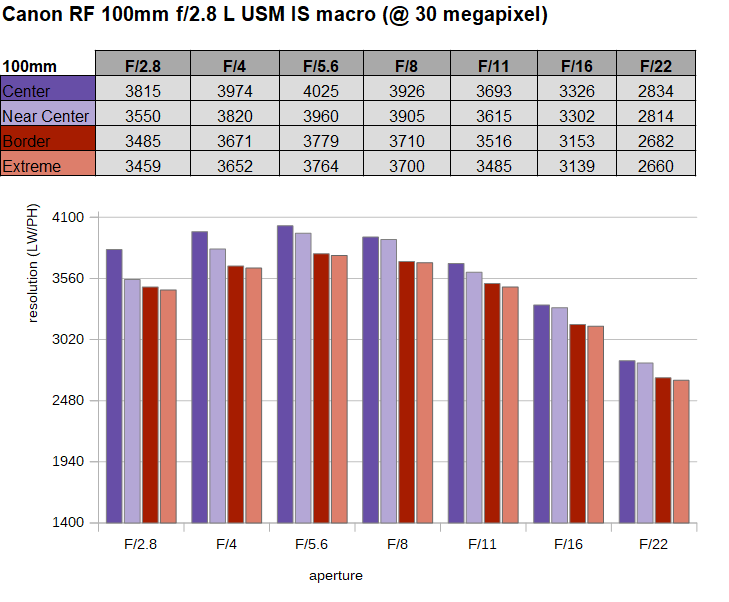|
Canon RF 100mm f/2.8 L USM IS macro - Review / Test Report - Analysis |
|
Lens Reviews -
Canon EOS (Full Format)
|
|
Page 2 of 3

Distortion
Macro lenses tend to be very well corrected in terms of image distortion. While not perfect with a ~0.3% pincushion distortion, it's much better corrected than your average mirrorless format lens.
And the remaining distortion can be easily auto-correct with minimal loss in image quality.
Vignetting
The vignetting figures aren't quite as impressive. For a medium tele-lens, the raw vignetting is very high (2 EV/f-stops) at f/2.8, although stopping down a little bit solves the problem already. However, auto-correction has to be quite invasive at a fully open aperture - resulting in increased sensor noise in the corners.

MTF (resolution) at 45 megapixels
The resolution characteristic of the Canon RF 100mm f/2.8 L USM IS macro is impressive even on a high megapixel body. Images are already sharp across the frame at f/2.8. Stopping down to f/4 lifts the quality a bit and the excellent peak performance is reached at f/5.6. Stopping down further limits the resolution due to diffraction. The quality is still very fine at f/11. f/16 is passable and f/22 should be avoided, really.
The centering quality of the lens was Ok but not great. The field curvature is minimal but present.
Please note that the MTF results are not directly comparable across the different systems!
Below is a simplified summary of the formal findings. The chart shows line widths per picture height (LW/PH) which can be taken as a measure of sharpness.
If you want to know more about the MTF50 figures you may check out the corresponding Imatest Explanations

MTF (resolution) at 30 megapixels
Not everybody has an expensive EOS R5, so some of our readers are surely interested in how the lens performs on a more sanely priced camera.
Unsurprisingly, the results are even better on pixel level due to the reduced pixel density. Once again you can, you can easily use the lens wide-open. f/22 remains unimpressive due to impressive. Please note that the MTF numbers are higher at f/22 compared to the 45mp chart because the edges are "sharper" and as such, more receptive to the mild default sharpening that we apply during RAW conversion.

Chromatic Aberrations (CAs)
Lateral CAs (color shadows at the image borders) are well controlled, with an average CA pixel width of around 0.8px. Auto-correction can fix this without impacting image quality.

Bokeh
Given the large max aperture and macro capabilities, the quality of the bokeh will be an interesting aspect for most users.
Out-of-focus highlights are nicely rendered. The discs have a very smooth inner zone and minimal outlining effect. Please note that the outlining gets emphasized when stopping down. The circular disc shape is maintained from f/2.8 to f/5.6 which is better than on most lenses.
 The above is true for the image center. As so often, the circular disc shape deteriorates to cat eyes in the image corners - fairly "early" at f/2.8 in this case. The "circular shape" zone broadens at f/4, although the corner discs look less pleasing. Fairly circular corner discs require f/5.6.
As far as the general blur is concerned, there are two flavors to discuss here. The background blur (shown to the left below) is very smooth and buttery whereas the foreground blur (to the right) is quite harsh.
The above is true for the image center. As so often, the circular disc shape deteriorates to cat eyes in the image corners - fairly "early" at f/2.8 in this case. The "circular shape" zone broadens at f/4, although the corner discs look less pleasing. Fairly circular corner discs require f/5.6.
As far as the general blur is concerned, there are two flavors to discuss here. The background blur (shown to the left below) is very smooth and buttery whereas the foreground blur (to the right) is quite harsh.

Bokeh Fringing
The Canon RF 100mm f/2.8 L USM IS macro isn't an apochromatic lens. However, surprisingly, axial CAs are minimal even at f/2.8. Stopping down eliminates the remaining color fringing traces.
As you may spot, the focus point moves to the rear when stopping down. These RSA (residual spherical aberration) are a bit surprising on a macro lens because they can get relevant at large-aperture settings in close-focus scenes.
Spherical Aberration Control
As mentioned in the introduction, the Canon lens features an SA control ring. You may be surprised to read that Spherical Aberration Control is not a new thing. Ages ago (1987), Canon released the EF 135mm f/2.8 Soft Focus which featured the mechanism already. Using the SA control ring between +/-2, you can move a lens element out of position introducing an optical defect. Depending on the setting this has a dramatic effect on the bokeh as well as overall image sharpness.
Let's check up the background highlights first. As you can see below a -2 setting produces "bubble" highlights whereas the +2 setting produces feathered discs.
Note: Sorry for the dirt in the highlight discs. Seems as if there were some particles on the rear element of the lens at the time of shooting.
The same with a little more background contexts:
If it weren't just about the out-of-focus blur, this would be great. However, introducing optical defects does affect the sharpness in the focus zone as well. The images below illustrate the haziness that is introduced here. While some may like this early 1900s style of quality, it is mostly just ... odd. You can find the full-size images in the sample image section on the next page.
Also, notice the shift in focal length - both shots were taken on a tripod at the same distance.
|